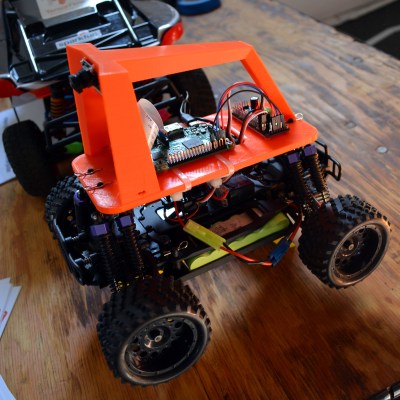You might think that you do not have what it takes to build a self-driving car, but you’re wrong. The mistake you’ve made is assuming that you’ll be controlling a two-ton death machine. Instead, you can give it a shot without the danger and on a relatively light budget. [Otavio] and [Will] got into self-driving vehicles using radio controlled (RC) cars.
[Otavio] slapped a MacBook Pro on an RC car to do the heavy lifting and called it carputer. The computer reads Hall effect sensor data from the motor to establish distance traveled (this can be used to calculate speed) and watches the stream from a webcam perched on the chassis. These two sources are fed into a neural network using TensorFlow. You train the system by driving the vehicle manually through the course a few times and then let it drive itself.
In the video interview below, you get a look at the car and [Otavio] gives commentary on how the system works as we see playback of a few races, including the Sparkfun 2016 Autonomous Vehicle Competition. I apologize for the poor audio, they lost the booth lottery and were next door to an incredibly noisy robot band (video proof) so we were basically shouting at each other. But I think you’ll agree it’s worth it to get a look at the races.
 The carputer is certainly a one-off and not the most beginner friendly build to take on. That’s where [Will] comes in. He is on the Donkey Car team. Donkey Car is a standard platform for autonomous vehicles. It’s a combination of about $200 in parts and some 3D-printed chassis pieces that will get you up and running after about two hours of assembly time. The brain of the Donkey is a Raspberry Pi 3, which we already know will run TensorFlow quite nicely.
The carputer is certainly a one-off and not the most beginner friendly build to take on. That’s where [Will] comes in. He is on the Donkey Car team. Donkey Car is a standard platform for autonomous vehicles. It’s a combination of about $200 in parts and some 3D-printed chassis pieces that will get you up and running after about two hours of assembly time. The brain of the Donkey is a Raspberry Pi 3, which we already know will run TensorFlow quite nicely.
The guides the Donkey Car team has put together are a really great start. They don’t sell a kit — it’s still a hacker’s project and we love that. If you have any bumps along the way with the build there’s a Slack channel the team hangs out in and would love to help you through your build. The only other issue is finding a track to test your car.
Have you been working on your own autonomous RC builds? We’d love to hear about them on the tips line!



















“You might think that you do not have what it takes to build a self-driving car, but you’re wrong.”
Considering it’s summer. A self-driving mower would be nice.
Looks good enough for the weed-whacker though!
WAIT! Even better! Constantly plow the sidewalk/driveway of snow. It could keep up with most snowstorms here.
That project looks like a lot of fun. My kids can’t do anything with drones as we are in a restricted zone so autonomous ground vehicles would be a fantastic alternative as we do have a lot of open and varied terrain that they can use. Except we had been talking about using something a little bigger, and going cross country, perhaps one of those $300 mini quad bikes with all the plastic and human friendly parts stripped off, a bigger fuel tank and the gearing changed for less speed and more torque. I wonder if a 50kg “toy” like that would be legal, if it stays under 20 km/hr?
Obviously, if you’re on your own property, any of your own vehicles, autonomous or not, are legal! Taking it on public roads, however…
Not planning to use the roads but we do have a lot of parkland and open space as we are on the edge of town. I guess it can’t be any worse than the people who let their kids ride minibikes around in the same places. Then again what could possibly go wrong…
If you have the time and money,i recommend you try going electric with it.
But where can I get an electronic mini quad for $300? By the time we did a conversion the price may have doubled, I’d rather spend the money on more CPUs and sensors so that the car was smarter. But running it on ethanol could be an option.
I love it!
Very cool and all, but an expensive macbook? Really?
Aside from the fact that there are plenty of smaller, more power efficient, and cheaper boards out there, think about what this this is powering.
It’s a self driving RC car. One “glitch” and that thing now is driving your 1000$+ laptop straight into a wall at 20+mph
maybe it’s what they had around, which is cheaper than buying a new laptop to do it?
You’ve met my Son?
it’s cool project
I wanna made it to
have you uploaded your code somewhere ?